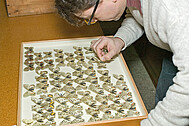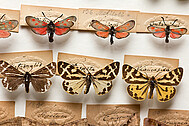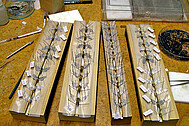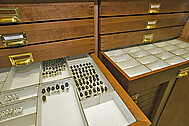Entomological Collections
Insects are an extremely diverse group of organisms, and species unknown to science are still being discovered. The small body size of many species is another reason why so many of them cannot be identified in the field. Therefore, many projects in research and conservation depend on voucher specimens. In a research collection such as the SMNK (State Museum of Natural History), these specimens help us and future generations to address important questions.
The total of mounted insects in our collection is currently ca. 3 million, stored in more than 20.000 insect drawers. Additional material is stored in a large alcohol- collection, especially of groups such as the springtails (Collembola). The main focus of the collection is on butterflies and moths (Lepidoptera), comprising ca. 2.4 million specimens. Other important parts of the collection are ants, bees, and wasps (Hymenoptera), beetles (Coleoptera), praying mantises (Mantodea) und true bugs (Heteroptera). For information on our collections of other insect groups see "Other insects".
The insect collection of the SMNK, like the entire museum, dates back to the cabinet of natural history of margravine Caroline Luise (1723-1783). Unfortunately, none of the few insect specimens from these formative years (1751-1783) survived. However, specimens contributed by Carl Christian Gmelin, the first director of the SMNK from 1785-1837, are still intact.
Under Max Auerbach, the director from 1902-1945, the scientific collections were separated from the public exhibitions, setting the foundation for an independent department of entomology. The first curator of entomology, Hermann Leininger, was hired in 1920. The most important acquisition during this time was the butterfly collection of Martin Daub in 1917. At the time, it was one of the largest collection in central Europe, containing almost 56.000 specimens of the Palearctic region.
During the bombing of September 2-3, 1942, the complete scientific insect collection was successfully evacuated from the fire at the collection house, but the provisional storage which followed led to some losses. It was not until 1964 that the dry and dust-free storage rooms on the second floor of the museum building were made available, the same place where the collection is still housed today.
In 2012, the collection room underwent a complete modernization including the installation of a mobile aisle shelving system. This ensures that there will be enough space to accommodate future acquisitions.










